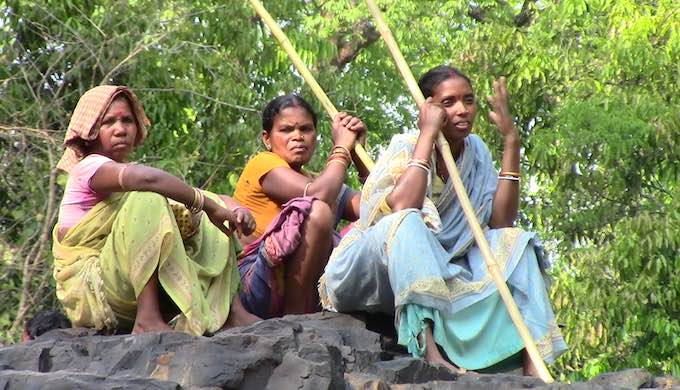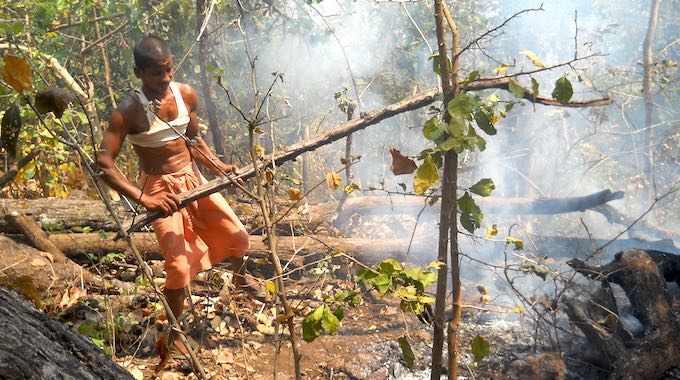By Ranjan K Panda —
There has been a new wave of admiration in India of our traditional knowledge, which has emerged in public discourse. But it’s not reflected in ways the State wants to manage our own forests. Politicians, intellectuals, and bureaucrats publically hold the importance of indigenous practices and knowledge. For example, Indian government champions cause of Yoga in international arena and successfully puts it on the world map by pushing for an International Yoga Day. In the same vein, traditional medicine that includes Ayurveda has become buzzword among policy-makers.
In the rush to promote India’s traditional practices and knowledge, policy-makers forget other long standing as well as rich traditions of India. Indians, particularly indigenous communities living in forests, live with and have been protecting India’s forests, which are full of biodiversity, for thousands of years. They have a repository of traditional and lived knowledge around forest ecosystem.
Many have demonstrated scientific methods of conservation, before the advent of modern forest science. Thousands of villages in India have been protecting forests for over decades. For instance, more than 10,000 communities in Odisha protect state owned forests, through voluntary labor and possess an understanding as well as commitment to conservation. The great number of scared groves in the country remain living testimony to traditional conservation ethics of the Indian tribal communities as well as the forest dwellers.
Indigenous people’s neglected tradition
Sadly, centralized forest governance system, of British colonial administration and continued by post Independence Indian State, has forgotten to recognize traditions and practices. It has also tried its best to destroy the systems to commercialize forests. This is happening when the world including the scientific community has started to realize the fact that natural forest conservation is one of the most important keys in our fight against the deadly challenge of climate change.
“Natural Climate Solutions (NCS) can provide one third of cost effective climate mitigation needed between now and 2030 to stabilize warming to below 2 deg. Celsius. Along with reductions in fossil fuel emissions, NCS offers a strong set of options for various nations to deliver on Paris Climate Agreement whereas improving soil productivity, cleaning air and water as well as maintaining biodiversity,” says a team of researchers and scientists led by BW Griscom.

Strengthen Forest Rights for Climate Change Action: Draft Forest Policy
In order to fulfill Paris Agreement Goals, as reflected in Nationally Determined Contribution (NDC), India has set mitigation strategies. These include increasing forest and tree cover by 5 mn hectares and improving quality of forest cover in another 5 mn hectares of forest land. According to estimations, this will create additional carbon sink of 2 to 3 bn tons of carbon dioxide equivalent (CO2e) by 2030. It is assumed this target is cumulative and will represent average annual carbon sink of 167–200 mn tons CO2e (MtCO2e) over 2016-2020. More than half of target can be achieved by Green India Mission, expected to enhance annual carbon sequestration by 100 MtCO2e.
India has been part of Bonn Challenge, which is a global effort to bring 150 mn hectare of deforested and degraded land for restoration by 2020, and this was later scaled up to aim for 350 million hectares by the year 2030. The Government of India has made a Bonn Challenge pledge in order to restore 13 mn hectares of degraded land by the year 2020 as well as an extra 8 mn hectare by 2030.
Can the ambitious goals be achieved?
India’s NDCs and Bonn Challenge goals are ambitious. Some organizations, monitoring country actions to meet Paris Climate Goals, rate India’s policy positively. The Climate Action Tracker (CAT), independent database, in its update on April 30 provides positive ratings to the country India. It maps the probability of attaining NDC targets in the yellow category which is compatible with rise of 2 deg Celsius from pre-Industrial times. The analyses show India can achieve NDC target under climate change and environmental policies.
The CAT analyses highlight the plan to add to India’s stored carbon must reach high targets in existing framework of National Green Mission and draft Forest Policy 2018. It states that draft National Forest Policy will better support India’s targets. However, analyses of proposed rules and regulations in draft policy show it would jeopardize chances of meeting India’s targets. Government of India on March 14 circulated new draft Forest Policy for comments. If adopted, policy will replace one from 1988. The 1988 policy signified historic shift in India’s forest governance as it recognized primacy of ecological value of forests and acknowledged first claim of tribal and forest-dwelling communities over forests. The landmark Forest Rights Act (FRA) came in 2006 and recognized legal right of tribal and forest-dwellers on forests.
New draft forest policy reverses gains of 1998 Policy
The new draft forest policy reverses gains of 1988 policy and Forest Rights Act as well as proposes regressive practices of forest governance based on needs of government along with private sector. Though draft shows intent to curb climate change and aims to promote mitigation as well as adaptation efforts, they aren’t supported adequately as it over turns focus of previous policy and vests absolute power on forest bureaucracy by removing role of local, indigenous, and tribal communities from management as well as conservation of forests. The draft policy is being criticized by ecologists, conservationists, tribals as well as community representatives. The primary criticism includes use of climate change threat to re-centralize power to forest bureaucracy at cost of communities; subversion of Forest Rights Act, as well as facilitation of land and forest grabbing, historically-owned and managed by tribal and other forest-dwellers by private companies for industrial plantations.
The strategy of bureaucracy led, large scale afforestation and forest restoration with involvement of the private sector would likely fail, lead to conflicts, and waste scarce financial resources. The opportunity for climate change mitigation and adaptation through a rights based forest protection as well as restoration movement provided by Forest Rights Act stands ignored in the draft Forest Policy. That is the reason Climate Scorecard, a USA based civil society coalition which monitors and ranks climate action of major Greenhouse Gas (GHG) emitting countries, rates India’s draft Forest Policy at lowest on a 4-level ranking system. The ranking, which has assessed the draft, takes into consideration views and comments from the Indian ecologists and forestry experts including Ramchandra Guha, Madhav Gadgil, Sharad Lele as well as serving foresters.
Compensatory afforestation is key: Draft forest policy
One month before draft Forest Policy was circulated, there was another proposed policy decision which was opened for public comments. On February 16, India’s environment ministry released draft Compensatory Afforestation Fund (CAF) Rules, 2018. The rules aim at undoing the FRA and plan to give almost absolute power to the Forest Department. According to CAF Rules, Forest Department would decide how USD 8 billion from Compensatory Afforestation Fund Management and Planning Authority (CAMPA) Fund will be utilized.
The CAF Rules do not respect rights granted to 200 mn indigenous and tribal people as well as forest dwellers by FRA and would likely promote monoculture plantations, displacing forest dwellers. Extensive documentation has been done which shows conflicts where communities have been displaced by plantations. Ignoring indigenous as well as local communities, who have been best managers of India’s natural forest resources as well as have helped preserve a majority of biodiversity rich forests is likely to lead to failure of CAMPA. The Indian government needs to revise these draft rules and incorporate suggestions by indigenous and forest based communities, environmentalists as well as activists.
Cancelling informed consent can be disastrous
The draft forest policy does away with provision of prior, free, and informed consent, known as FPIC, of village councils of forest communities before compensatory afforestation projects. This would create risk of dispossession as well as displacement for the most vulnerable forest communities in the world. India’s forestry targets have been criticized by local as well as tribal communities and civil society for focusing on commercial monoculture and ignoring community rights over forest. The latest steps by the Indian government which will dilute forest right of communities raise doubts over India’s commitment to socially just and sustainable path to achieve Paris Climate Agreement goals. If we love indigenous culture and practices, then we mustn’t ignore role of indigenous communities in protecting natural forests which are rich in biodiversity.
In a recent research which analyzed the contribution of local communities’ to climate change mitigation by assessing carbon storage in collective lands, it got established that communities which claim and own collective lands have sequestered around 54,546 million tons of carbon equivalent, which is about 4 times the world’s annual emissions. The study, which was carried out by Rights and Resources Initiative, Woods Hole Research Centre and World Resources Institute, calls for recognition of world’s indigenous and local communities in climate stabilization and carbon sequestration.
The Indian government has to consider the issues and experiences before going ahead with finalization of draft Forest Policy and CAF rules. We need to recognize traditional forest conservation practices, ensure rights of indigenous communities over the forests and facilitate role in meeting climate goals. Ignoring community rights over forests and forest science, which confirms natural biodiversity rich forests mitigate climate impacts the best, will be disastrous.
A version first appeared on India Climate Dialogue.
Photo credits: Ranjan K Panda
- India bets big on green tech: Budget 2023 - February 7, 2023
- Do Hrithik Roshan or Ronnie Coleman have zero percent body fat? - July 14, 2022
- Does sweating burn your fat? Not at all - July 12, 2022
- 5 green cars in India with low emissions to combat Air Pollution - March 11, 2022
- Adidas Is creating shoes out of recycled ocean plastic - May 31, 2021
- What is Community-based Tourism and How It Can Preserve Local Culture - May 26, 2021
- Sunderlal Bahuguna, Noted Indian Environmentalist, Dies from Corona Virus - May 22, 2021
- World’s largest Floating Solar Power Plant Is in China - April 15, 2021
- Meet the Man Fighting for the Environment in Kashmir - February 18, 2021
- Wallistry Develops Clay Water Bottles that are 100% bio-degradable - July 25, 2020

